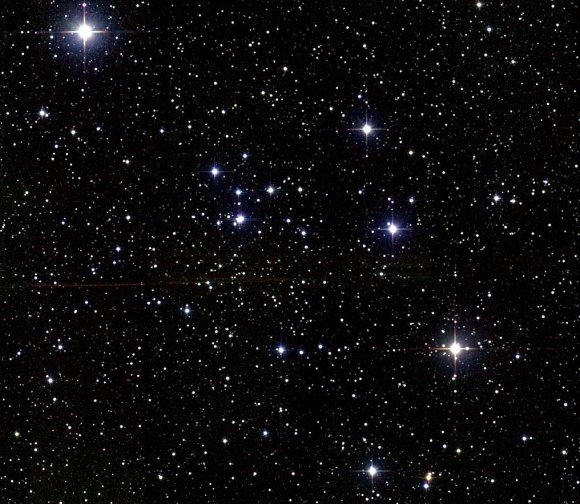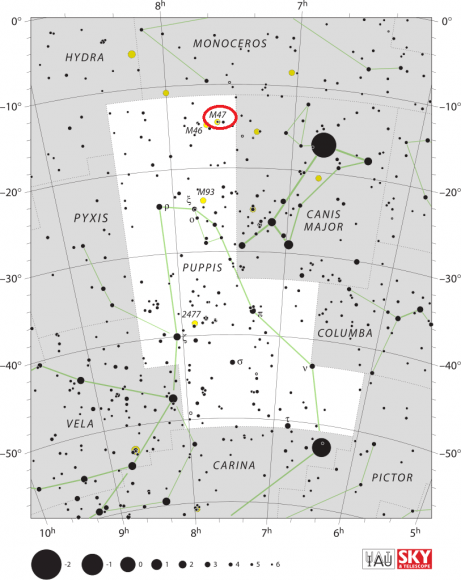Welcome back to Messier Monday! In our ongoing tribute to the great Tammy Plotner, we take a look at Orion's Nebula's "little brother", the De Marian's Nebula!
During the 18th century, famed French astronomer Charles Messier noted the presence of several "nebulous objects" in the night sky. Having originally mistaken them for comets, he began compiling a list of them so that others would not make the same mistake he did. In time, this list (known as the Messier Catalog) would come to include 100 of the most fabulous objects in the night sky.
One of these objects is the open star cluster known as Messier 47 (NGC 2422), which is located in the constellation of Puppis roughly 1,600 light-years from Earth. Located in proximity to Messier 46, this star cluster is estimated to be 78 million years in age. It is also particularly bright, containing about 50 stars and occupying a region that is about the same size as that of the full Moon.
Description:
Spanning across about 12 light years of space, this clump of around 50 stars began their life around 78 million years ago. Now cruising through space some 1600 light years away from Earth, the group continues to distance itself from our solar system at a speed of 9 kilometers per second. For the most part, Messier 47 is a whole lot like the Pleiades star cluster - its brightest member shining just around magnitude 6 and holding a spectral class B2.
But, here you will also find two orange K giants with luminosity of about 200 times that of the Sun. At M47's center you'll find binary star, Sigma 1121, with components of magnitude 7.9 both and separated by 7.4 arc seconds. How do we know that M47 is a lot like the Pleiades? Let's try X-ray sources and the advances of looking at open clusters far more differently than in optical wavelengths. As M. Barbera (et al) said in a 2002 study:
"We present the results of a ROSAT study of NGC 2422, a southern open cluster at a distance of about 470 pc, with an age close to the Pleiades. Source detection was performed on two observations, a 10-ks PSPC and a 40-ks HRI pointing, with a detection algorithm based on wavelet transforms, particularly suited to detecting faint sources in crowded fields. We have detected 78 sources, 13 of which were detected only with the HRI, and 37 detected only with the PSPC. For each source, we have computed the 0.2-2.0 keV X-ray flux. Using optical data from the literature and our own low-dispersion spectroscopic observations, we find candidate optical counterparts for 62 X-ray sources, with more than 80% of these counterparts being late type stars. The number of sources (38 of 62) with high membership probability counterparts is consistent with that expected for Galactic plane observations at our sensitivity. We have computed maximum likelihood X-ray luminosity functions (XLF) for F and early-G type stars with high membership probability. Heavy data censoring due to our limited sensitivity permits determination of only the high-luminosity tails of the XLFs; the distributions are indistinguishable from those of the nearly coeval Pleiades cluster."
What else might be hiding inside Messier 47? Try new debris disk candidates. As Nadya Gorlova (et al) indicated in a 2004 study:
"Sixty-three members of the 100 Myr old open cluster M47 (NGC 2422) have been detected with the Spitzer Space Telescope. The Be star V 378 Pup shows an excess both in the near-infrared, probably due to free-free emission from the gaseous envelope. Seven other early-type stars show smaller excesses. Among late-type stars, two show large excesses. P1121 is the first known main-sequence star showing an excess comparable to that of Beta Pic, which may indicate the presence of an exceptionally massive debris disk. It is possible that a major planetesimal collision has occurred in this system, consistent with the few hundred Myr timescales estimated for the clearing of the solar system."

Iof the star cluster Messier 47 taken by the Wide Field Imager camera on the 2.2-metre telescope at ESO's La Silla Observatory in Chile. Credit: ESO
History of Observation:
Messier 47 was originally discovered before 1654 by Hodierna who described it as:
"[A] Nebulosa between the two dogs"... but it was an observation that wasn't known about until long after Charles Messier independently recovered it on February 19, 1771. "Cluster of stars, little distant from the preceding; the stars are greater; the middle of the cluster was compared with the same star, 2 Navis. The cluster contains no nebulosity."
However, it was one of those very rare circumstances when Messier actually made a mistake in his position calculations. Despite this error, the cluster was observed by Caroline Herschel and identified as M47 at least twice in early 1783.
As a consequence of Messier's position mistake, Sir William Herschel also independently rediscovered it on February 4, 1785, and gave it the number H VIII.38. "A cluster of pretty compressed large [bright] and small [faint] stars. Round. Above [more than] 15' diameter." It would be John Herschel, on December 16, 1827, who would be the first to resolve Sigma 1121: "The chief star of a large, pretty rich, straggling cluster. It [the star] is double."

Atlas Image mosaic obtained of Messier 47 as part of the Two Micron All Sky Survey (2MASS). Credit: UMass/IPAC/Caltech/NASA/NSF
The "Messy" mistake would haunt star catalogs - including both Herschel's and Dreyer's for years, until the whole clerical error was cleared up by Owen Gingerich in 1960:
"More explicit reasons for this identification [of M47 with NGC 2422] were given independently in 1959 by T.F. Morris, a member of the Messier Club of the Royal Astronomical Society of Canada's Montreal Centre. Dr. Morris suggested that an error in signs in the difference between M47 and the comparison star could account for the position. Messier determined the declination of a nebula or cluster by measuring the difference between the object and a comparison star of known declination. The right ascension could be found by recording the times at which the object and the star drifted across a central wire in his telescope's field; the time interval gives the difference in right ascension. The differences between Messier's 1770 [actually 1771] position for M47 and his stated comparison star, 2 Navis (now 2 Puppis), if applied with opposite signs, leads to NGC 2422. Clearly, Messier made a mistake in computation!"
May you have Caroline Herschel's luck finding it!
Locating Messier 47:
There is no simple way of finding Messier 47 in the finderscope of a telescope, but it's not too hard with binoculars. Begin your hunt a little more than a fist width east/northeast of bright Sirius (Alpha Canis Majoris)... or about 5 degrees (3 finger widths) south of Alpha Monoceros. (It can sometimes by seen with the unaided eye under good conditions as a dim nebulosity.) There you will find two open clusters that will usually appear in the same average binocular field of view.

Messier 47 location. Image: IAU and Sky & Telescope magazine (Roger Sinnott & Rick Fienberg)
M47 is the westernmost of the pair. It will appear slightly brighter and the stars will be more fewer and more clearly visible. In the finderscope it will appear as if it is resolving, while neighboring eastern M46 will just look like a foggy patch. Because M47's stars are brighter, it is better suited to less than perfect sky conditions, showing as a compression that begins to resolve in binoculars and will resolves almost fully even a small telescope.
And here are the quick facts on this Messier Object to help you get started:
Object Name: Messier 47
Alternative Designations: M47, NGC 2422
Object Type: Open Galactic Star Cluster
Constellation: Puppis
Right Ascension: 07 : 36.6 (h:m)
Declination: -14 : 30 (deg:m)
Distance: 1.6 (kly)
Visual Brightness: 5.2 (mag)
Apparent Dimension: 30.0 (arc min)
We have written many interesting articles about Messier Objects here at Universe Today. Here's Tammy Plotner's Introduction to the Messier Objects, , M1 – The Crab Nebula, M8 – The Lagoon Nebula, and David Dickison's articles on the 2013 and 2014 Messier Marathons.
Be to sure to check out our complete Messier Catalog. And for more information, check out the SEDS Messier Database.
Sources:
No comments:
Post a Comment